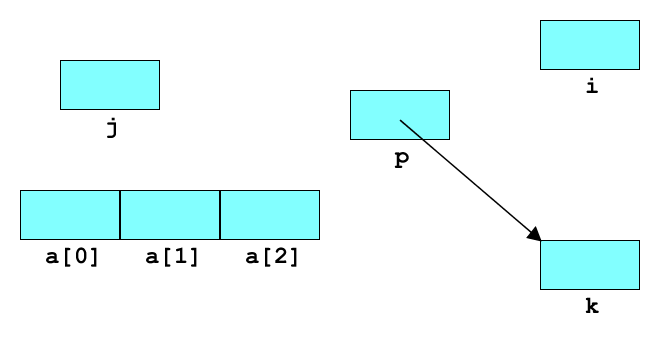

This chapter is about what pointers are
The next (objects) is about how to use pointers to pass data around in programs
The one after (memory) is about how to use pointers to manage memory in programs
A pointer allows you to store something such as a string or array that has a different size at different times
And it is used with dynamic allocation, to allow an item's lifetime to be more flexible than the duration of a single function call
A computer's memory is an array of bytes:

You can pick out one byte using its index
That's called the address of the byte
In C, you can assume that addresses are always byte-based (not bit-based or word-based)
Suppose a section of memory holds ints

The address of an int is still a byte-address
Int addresses go up in 4's (assuming 4-byte ints)
But if the ints form an array, you want to index it by 0,1,2..., not 0,4,8...
A pointer is an address in memory, together with the type and size of the item stored at that address
The type of a pointer to an int is int * ('int pointer')
C gives you direct and total access to pointers, but without worrying about exactly what the addresses actually are
A pointer has 4 bytes (on a 32-bit system) or 8 bytes (on a 64-bit system, to beat the 4Gb limit)
Pointers can be stored in memory, in variables
int i, j, k; int a[3]; int *p;
p is declared to be of type int * and
must point to the beginning or end of an actual int in memory
For example, p could point to the location of i or
of j or of k, or to any of the elements of the
array a, or to the end of the array
Suppose p is made to point to k
It is important, when programming or debugging, to create pictures of pointers, in your head or on paper

We don't know how memory is allocated, so the picture of p pointing to k could equally well be

Since we don't know (and don't need to know) where things are located in memory, we often picture them 'randomly' scattered:

Should you write int *p or int* p ?
In the first case, beware that int *p = x;
means int *p; p = x; even though it looks like
int *p; *p = x;
In the second case, beware that int* p, q; means int* p; int q; even though it looks likeint* p; int* q;
It is a no-win situation, so let's follow the most common convention and write int *p
Why are C's types written in this way?
With pointers, types can get very complicated, and the designers wanted types to be written the same way round as the operations performed on the variables, not the opposite way round
A declaration is written as an example of using the variable, plus the basic type you reach at the end
So int *p means "p is a variable to which you can apply the * operator, and then you reach an int"
If a pointer variable p of type int * points to an
int, then the expression p+1 points one
int further on
For example, if p points to a[1] then
p+1 points to a[2]
The C compiler uses the knowledge of the type of the item which a pointer points to, and its size, to make the arithmetic as convenient as possible
If you need to know a size (in bytes) yourself, apply the
sizeof() pseudo-function to a variable or a type
The & operator takes a variable, and creates a pointer to
its memory location

The * operator takes a pointer, and follows it to find the value
stored at that memory location

These go in 'opposite directions' along the pointer
& operatorThe & operator creates a pointer to a variable
/* Print a pointer. */
#include <stdio.h>
int main() {
int n;
int *p = &n;
printf("pointer %p\n", p);
}
The expression &n is often read "address of n", even though it should really be "pointer to n"
* operatorThe * operator finds the value which a pointer refers to
/* Print a value. */
#include <stdio.h>
int main() {
int n = 42;
int *p = &n;
printf("value %d\n", *p);
}
NULLOne special pointer is provided in C, called NULL, available
from stdio.h for example
Don't confuse it with the null character, written '\0',
which is only one byte long
The NULL pointer is guaranteed to be unusable (it points to
location 0 which belongs to the OS)
It is used for uninitialised pointers, as an error indicator for functions that return pointers, and so on
Here's a deliberate segfault:
/* Demo: cause a segfault */
#include <stdio.h>
int main() {
// Point to the beginning of the memory
char *s = NULL;
// Demonstrate that it doesn't belong to us
s[0] = 'x';
}